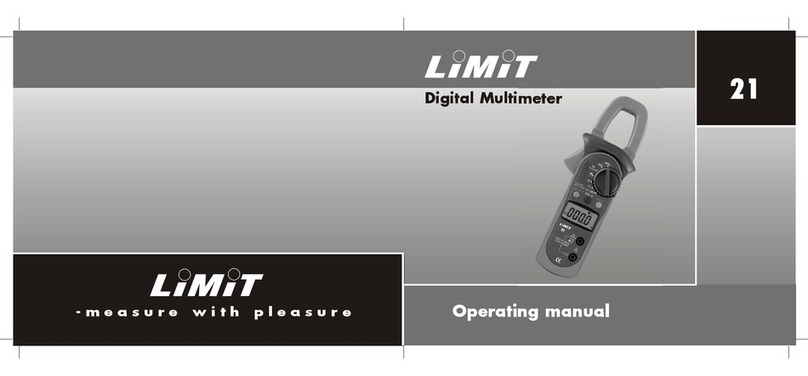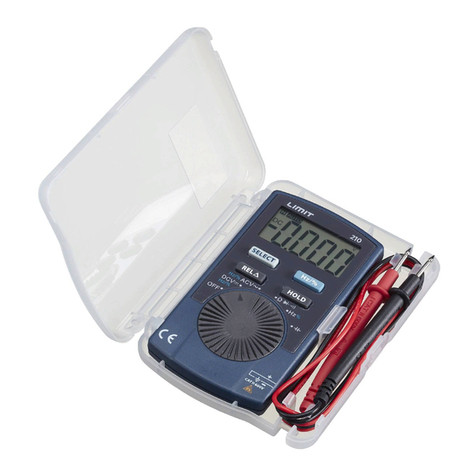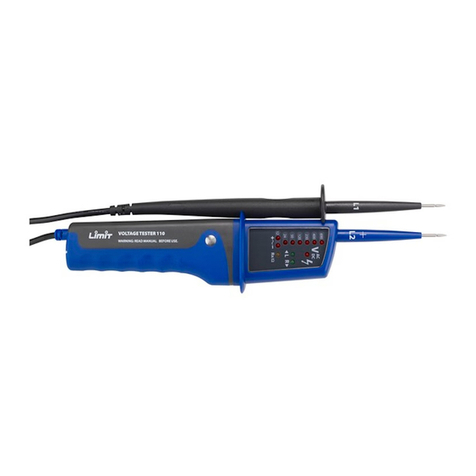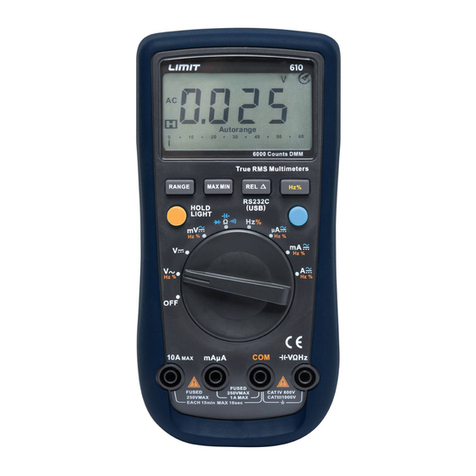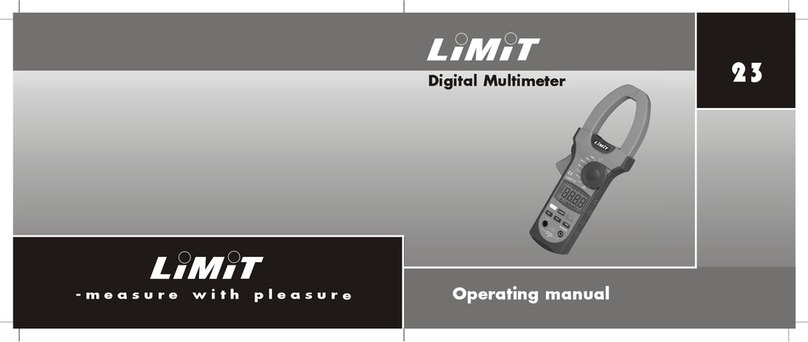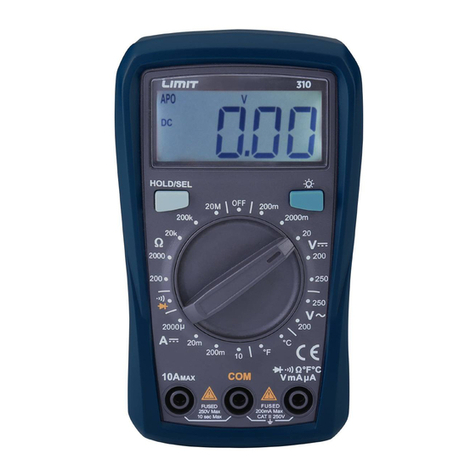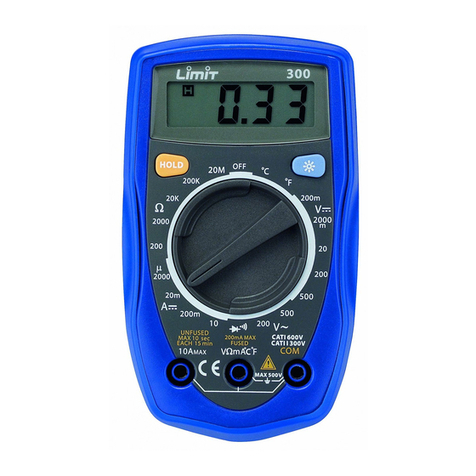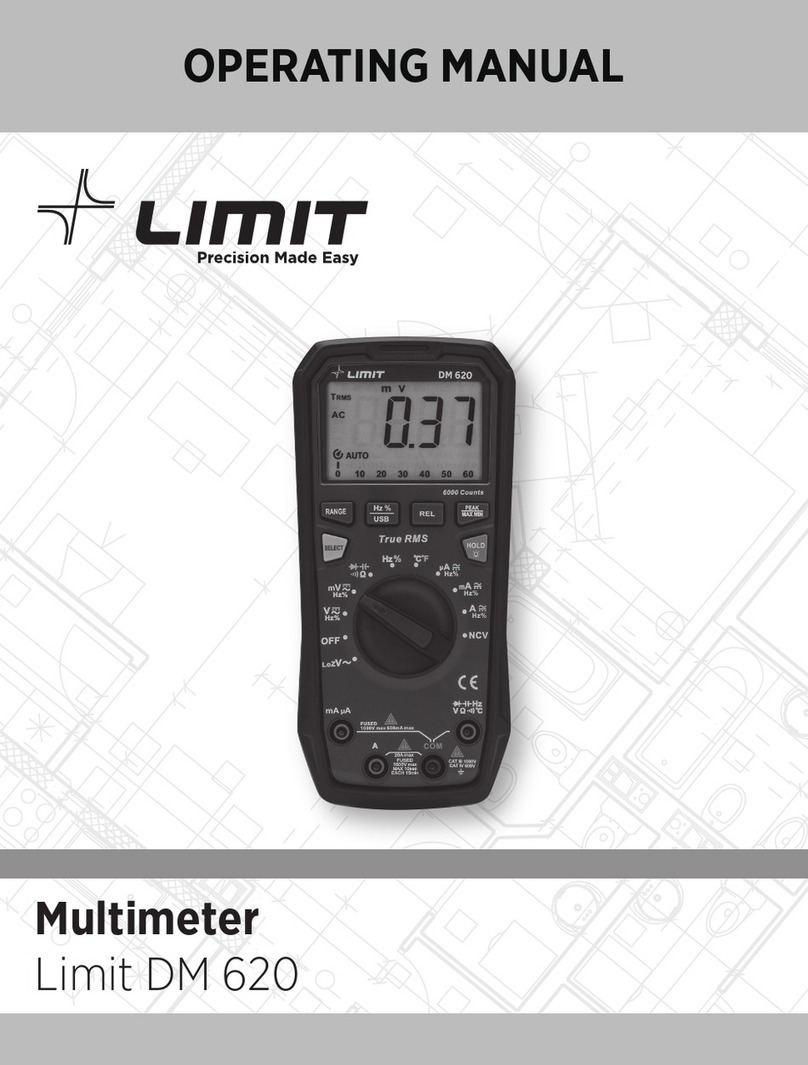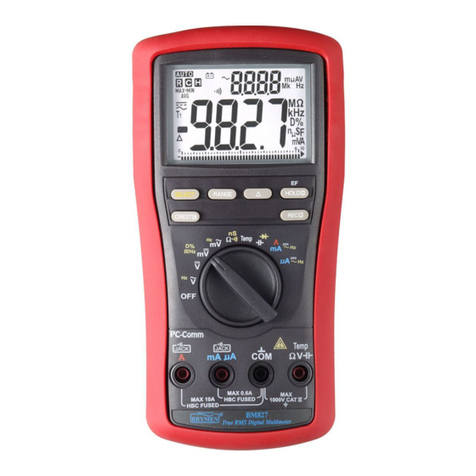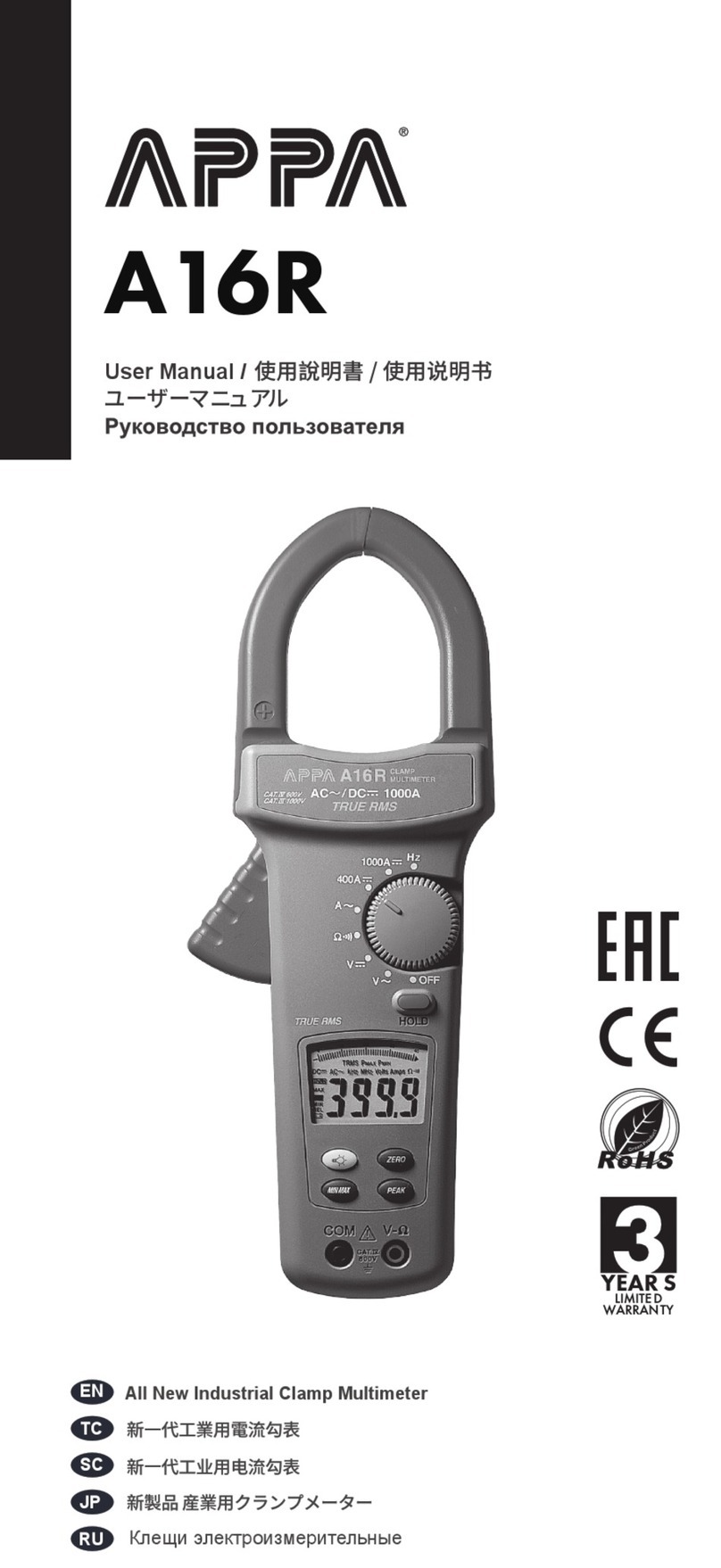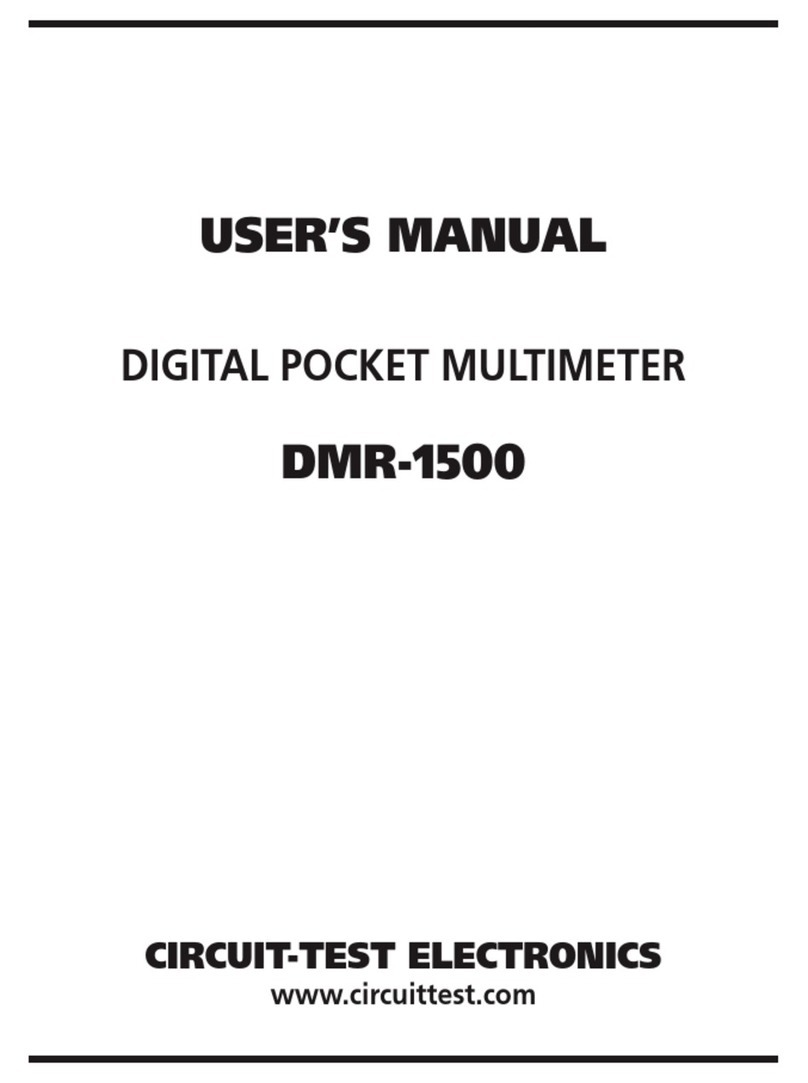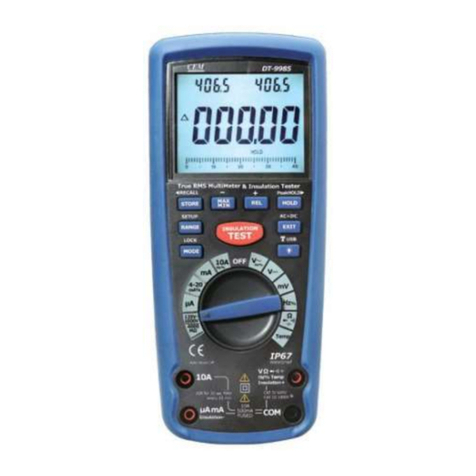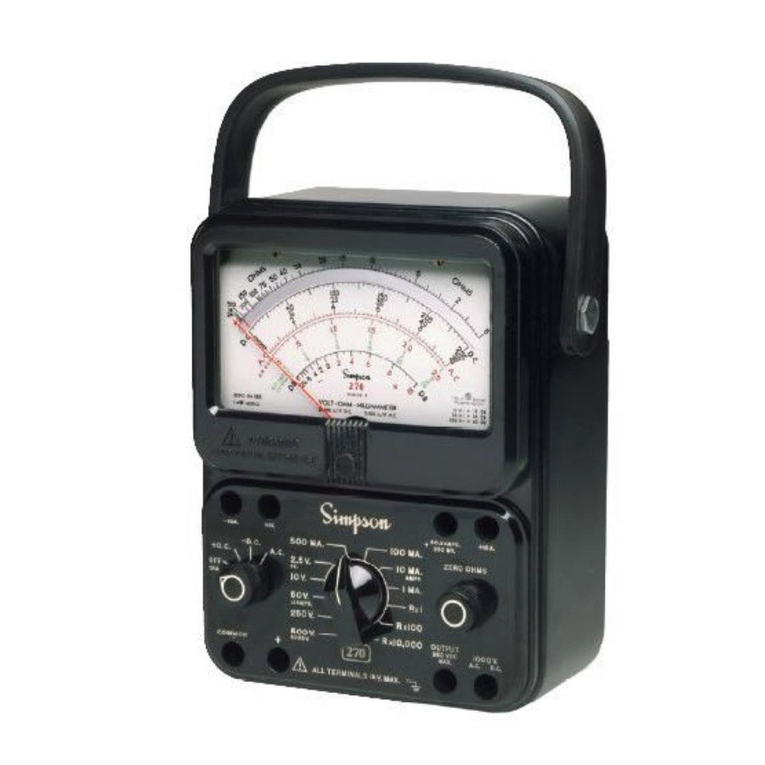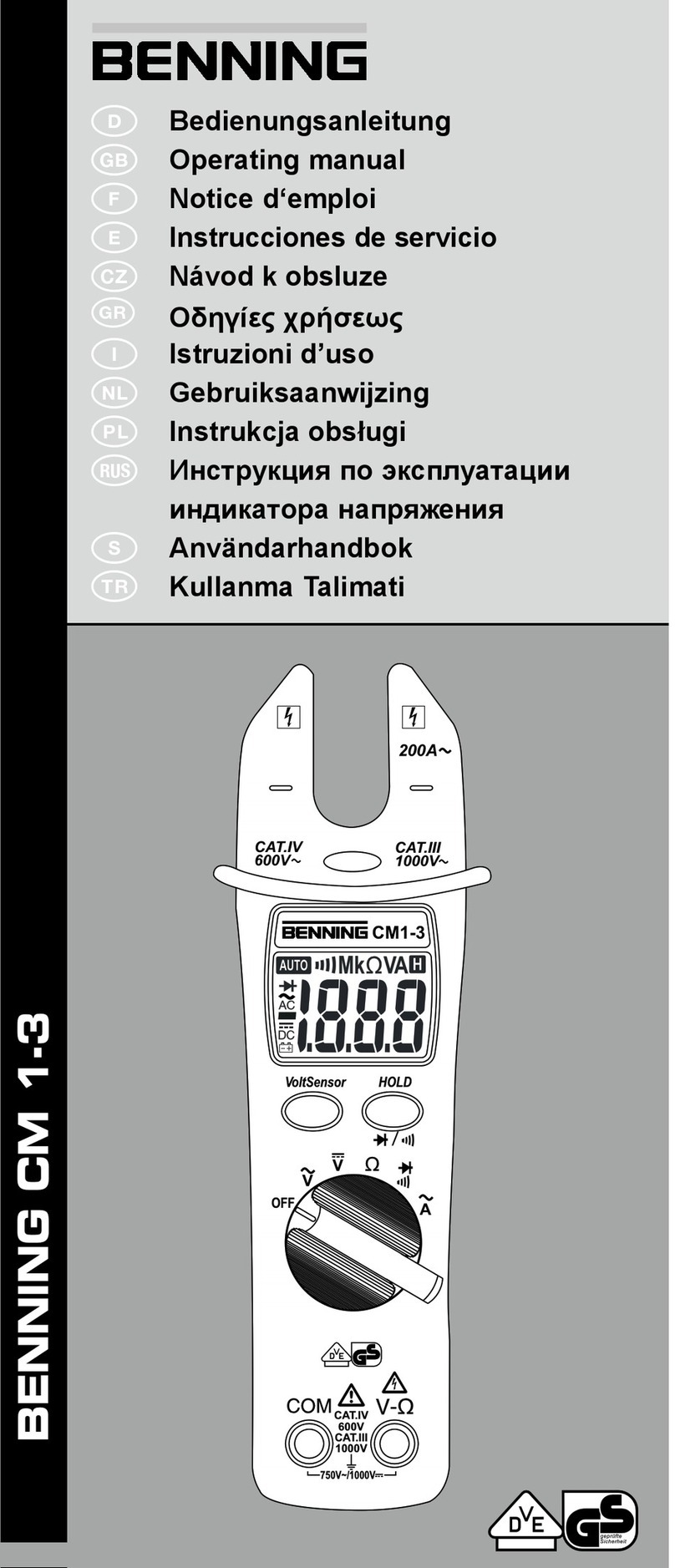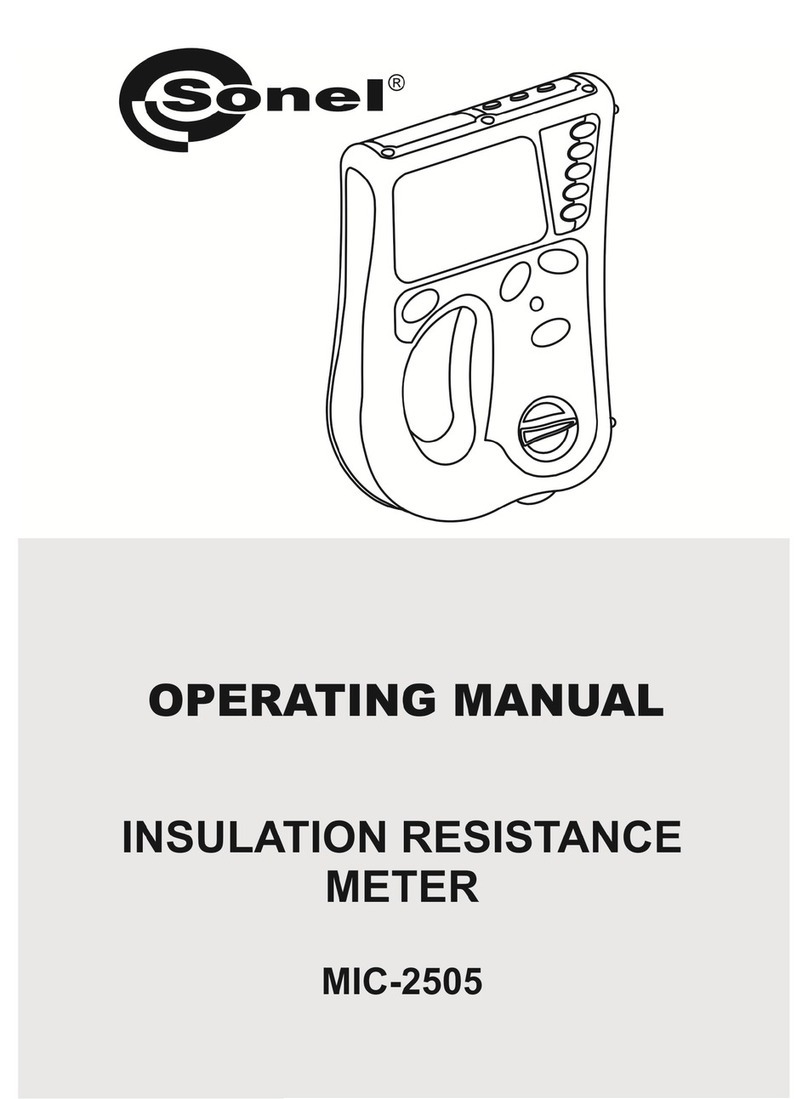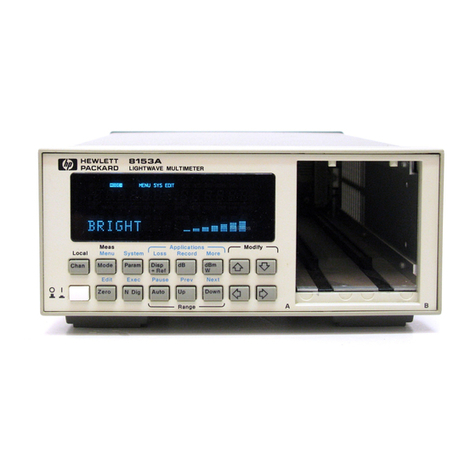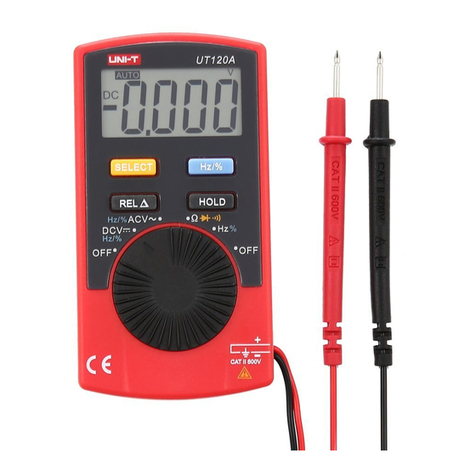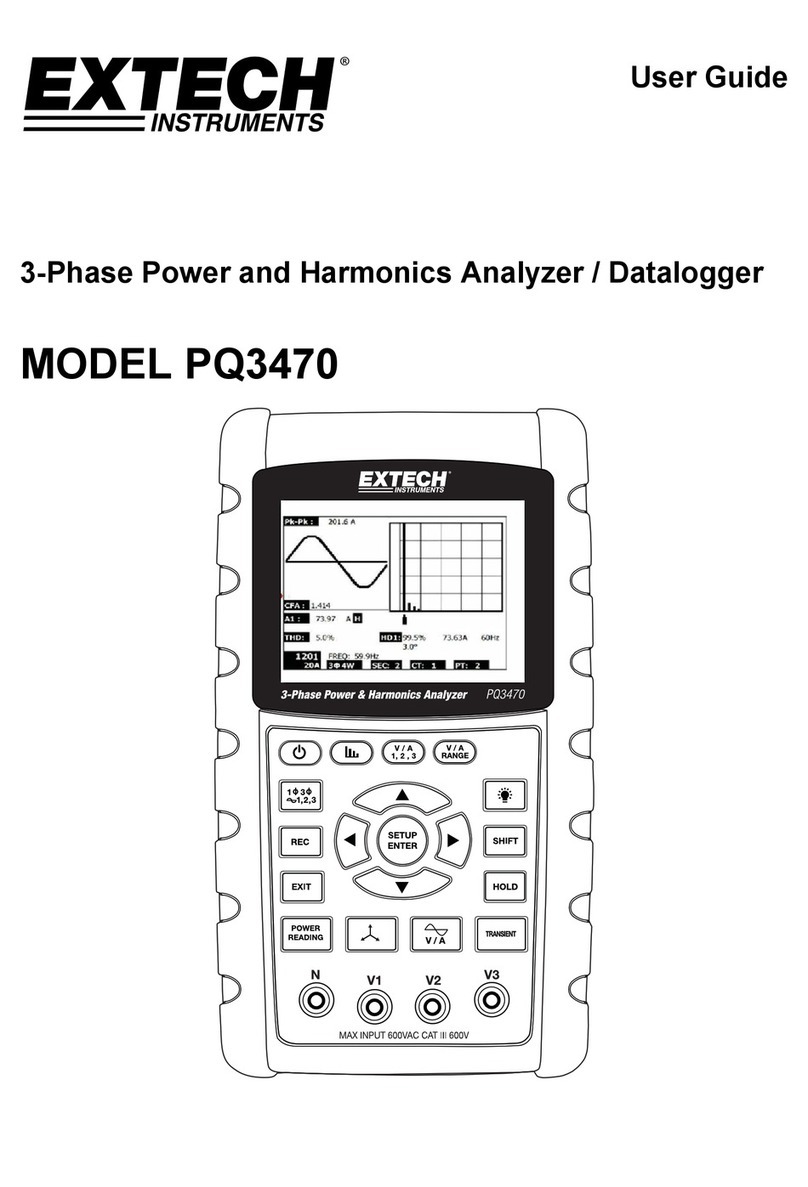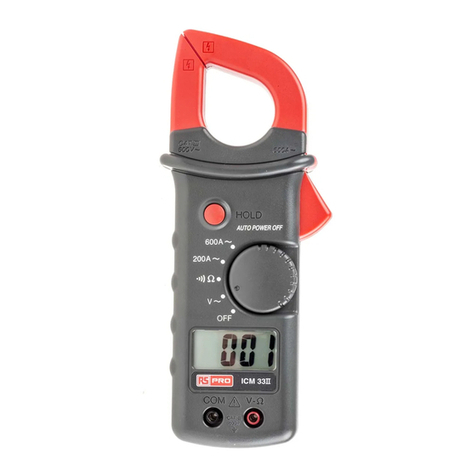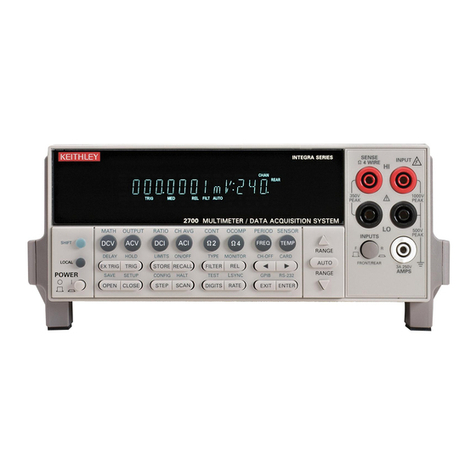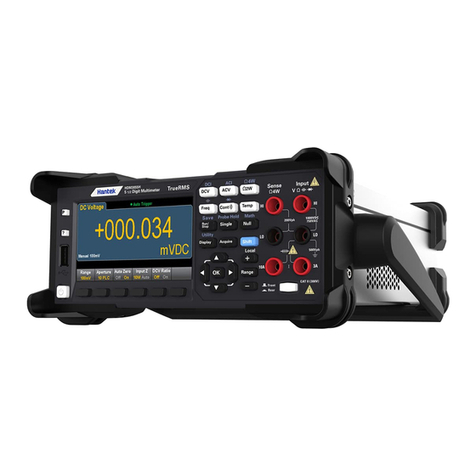LIMIT 400 User manual

Illustrations
Screw
Black Red
Black Red
Black Red
Fig 1 Fig 2
Fig 3 Fig 4
Fig 5 Fig 6 Fig 7

A. DC voltage
Range Resolution Accuracy Overload protection
UT39A UT39B UT39C
200mV 100µV
±(0.5%+1)
250V DC or AC rms
2V 1mV
1000V DC
or 750V AC
20V 10mV
200V 100mV
1000V 1V ±(0.8%+2)
Remark:
• Input impedance: 10MΩ.
B. AC voltage
Range Resolution Accuracy Overload protection
UT39A UT39B UT39C
2V 1mV
±(0.8%+3) 1000V DC
or 750V AC
20V 10mV
200V 100mV
750V 1V ±(1.2%+3)
Remark:
• Input impedance: 10MΩ.
• Frequency response: 40Hz ~ 400Hz.
• Display effective value of sine wave (mean value response).
C. DC current
Range Resolution Accuracy Overload protection
UT39A UT39B UT39C
20µA 0.01µA ±(2%+5)
0.315A. 250V
fast type fuse,
ø5x20mm
200µA 0.1µA
±(0.8%+3)
2mA 1µA ±(0.8%+1)
±(0.8%+1)
20mA 10µA
200mA 100µA ±(1.5%+1)
10A/20A 10mA ±(2%+5) Un-fused
Remark:
• UT39A/UT39B-At 10A range: For continuous measurement ≤10 seconds and interval not less than 15
minutes.
• UT39C-At 20A range: For continuous measurement ≤10 seconds and interval not less than 15 minutes.
• Measurement voltage drop: Full range at 200mV.
Illustrations

D. AC current
Range Resolution Accuracy Overload protection
UT39A UT39B UT39C
200µA 0.1µA
±(1%+3)
0.315A. 250V
fast type fuse,
ø5x20mm
2mA 1µA ±(1%+3)
20mA 10µA
±(1%+3)
200mA 100µA ±(1.8%+3)
10A/20A 10mA ±(3%+5) Un-fused
Remark:
• UT39A/UT39B-At 10A range: For continuous measurement ≤ 10 seconds and interval not less than 15
minutes.
• UT39C-At 20A range: For continuous measurement ≤ 10 seconds and interval not less than 15 minutes.
• Measurement voltage drop: Full range at 200mV.
• Frequency reaponse: 40Hz ~ 400Hz.
• Display effective value of sine wave (mean value response).
E. Resistance test
Range Resolution Accuracy Overload protection
UT39A UT39B UT39C
200Ω 0.1Ω ±(0.8%+3)
250V DC
or AC rms
2kΩ 1Ω
±(0.8%+1)
±(0.8%+1)
20kΩ 10Ω
200kΩ 100Ω
2MΩ 1kΩ ±(0.8%+1)
20MΩ 10kΩ ±(1%+2)
200MΩ 100kΩ
±[5%(reading-10)+10]
Remark:
• Open circuit voltage:
At 200MΩ range: approx. 3V
Other ranges: ≤ 700mV
• At 200MΩ range, test lead is in short circuit, and it is normal to display 10 digits. During measurement,
subtract the 10 digits from the reading.
F. The mode UT39C: Frequency
Range Resolution Accuracy Overload protection
2kHz 1Hz ±(2%+5) 250V AC
20kHz 10Hz ±(1.5%+5)
Remark:
• Input sensitivity: ≤ 200mV.
• When the input voltage is ≥ 30V rms, no guaranteed accuracy.
Illustrations

G. Temperature
Range Resolution Accuracy Overload protection
-40°C ~ 0°C
1°C
±(4%+4)
250V AC1°C ~ 400°C ±(2%+8)
401°C ~ 1000°C ±(3%+10)
H. Capacitance
Range Resolution Accuracy Overload protection
UT39A UT39B UT39C
2nF 1pF ±(4%+3)
250V AC
200nF 0.1nF
2µF 1nF
±(4%+3)
20µF 10nF ±(4%+3)
Remark:
• Testing signal: approx. 400Hz, 40mV rms.
I. Diodes and continuity test
Function Range Resolution Input
Protection Remark
Diode 1mV 250V DC
or AC
Open circuit voltage
approx.2.8V
Continuty
buzzer 1Ω Approx. ﹤70Ω buzzer
beeps continuously
J. Transistor test
Range Remark Overload protection
hFE Can measure NPN or PNP
transistor. Display range: 0-1000β
Vce ≈ 2.8V
I bo ≈ 10µA
Illustrations

400
English.....................................................................................................................1
Svenska..................................................................................................................5
Norsk ........................................................................................................................9
Dansk ....................................................................................................................13
Suomi ....................................................................................................................17
Deutsch................................................................................................................21
Netherlands .................................................................................................... 25
Français...............................................................................................................29
Italiano..................................................................................................................33
Español................................................................................................................37
Português...........................................................................................................41
Polski.....................................................................................................................45
Eesti........................................................................................................................49
Lietuviškai ..........................................................................................................53
Latviski..................................................................................................................57

1
English
Limit 400
Operating manual
ENGLISH
Contents
Overview
General specication
Safety information
Voltage DC and AC
Current DC and AC
Resistance
Temperature
Diodes test
Continuity test
Capacitance
Transistor test
Frequency
Battery
Fuses
Overview
This Operating Manual covers information on safety and cautions. Please read the relevant information
carefully and observe all the Warnings and Notes strictly.
Multimeter Limit 400 is made for professional and indoor use.
General Specications
Measuring range and accuracy see page 2.
• Manual ranging
• Automatic off after 15 minutes.
• Maximum Display: Display: 1999 or 3½ digits.
• Measurement Speed: Updates 2-3 times /second.
• Temperature measuring system Type K.
• Operation temperature: 0°C~40°C Storage temperature: -10°C~50°C
• Battery 9V, type 6F22.
• Fuse 0,315A, 250V fast type, 5x20 mm
• Safety/Compliances: IEC61010 CAT II 1000V, CAT I 600 V over voltage and double insulation standard.
Certication: CE.
Safety Information
This Meter complies with the standards IEC61010 Isolation category CAT II 600V, CAT I 1000V.
Warning
To avoid possible electric shock or personal injury, and to avoid possible damage to the Meter or to the
equipment under test, adhere to the following rules:
• Before using the Meter inspect the case. Do not use the Meter if it is damaged or the case (or part of the
case) is removed. Look for cracks or missing plastics. Pay attention to the insulation around the connectors.
• Inspect the test leads for damages insulation or exposed metal. Check the test leads for continuity.
• Do not apply more than the rated voltage, as marked on the Meter, between the terminals or between any
terminal and the grounding.
• The rotary switch should be placed in the right position and no any changeover of range shall be made

2
English
during measurement is conducted to prevent damage of the Meter.
• When the Meter working at an effective voltage over 60V in DC or 42V rms in AC, special care should be
taken for there is danger of electric shock.
• Do not use or store the Meter in an environment of high temperature; humidity, explosive, inammable and
strong magnetic elds. The performance of the Meter may deteriorate after dampened.
• When using the test leads, keep your ngers behind the nger guards.
• Disconnect circuit power and discharge all high-voltage capacitors before testing resistance, continuity,
diodes and current.
• Before measuring current, check the Meter fuses and turn off power to circuit before connecting the Meter
to the circuit.
• Replace the battery as soon as the battery indicator appears. Whit to low battery, the Meter might produce
false readings that can lead to electric shock and personal injury.
Functional buttons
Power • On/Off switch. Automatic off after 15 minutes.
Hold • Hold function. H shows on the display when value is hold.
Voltage measurement DC and AC (Fig 1)
1. Insert the red test lead into the VΩHzºC terminal and the black test lead into the COM terminal.
2. Set the rotary switch to an appropriate measurement position in V--range for DC or V~ for AC. When the
value is unknown always start from the max range 1000 V.
3. Connect the test leads across with the object being measured.The measured value shows on the display.
Note
• Displays 1 selected range is overload; it is required to select a higher range in order to obtain a correct
reading.
• In each range, the Meter has an input impedance of approx.10MΩ. This loading effect can cause
measurement errors in high impedance circuits. If the circuit impedance is less than or equal to 10kΩ, the
error is negligible.
Current measurement DC and AC (Fig 2).
Warning
Never attempt an in-circuit current measurement where the voltage is greater than 250 V. If the fuse burns
out during measurement, the Meter may be damaged or the operator himself may be hurt. When the testing
leads are connected to the current terminals, do not parallel them across any circuit.
Measuring time for current over 10A should be less than 10 sec and interval between measurement should be
at least 15 minutes.
1. Turn off power to the circuit. Discharge all high-voltage capacitors.
2. Insert the red test lead into the A or mA terminal and the black test lead into the COM terminal.
3. Set the rotary switch to an appropriate measurement position A-- range for DC or A~ for AC. When the
value is unknown always start from the max range 20 A.
4. Break the current path to be tested. Connect the red test lead to the more positive side of the break and the
black test lead to the more negative side of the break.
5. Turn on power to the circuit. The measured value shows on the display.
Note
• Displays 1 selected range is overload, it is required to select a higher range in order to obtain a correct
reading.
Resistance measurement (Fig 1)
1. Insert the red test lead into the VΩHzºC terminal and the black test lead into the COM terminal.
2. Set the rotary switch to an appropriate measurement position in Ω range.
3. Connect the test leads across with the object being measured. The measured value shows on the display.

3
English
Note
• The test leads can add 0.1Ω to 0.3Ω of error to resistance measurement. To obtain precision readings in
low-resistance measurement, under 200Ω, short-circuit the input terminals before and record the reading
obtained. This is the additional resistance from the test lead.
Temperature measurement (Fig 3).
The included point contact temperature probe can only be used up to 250 °C. For measuring higher
temperatures another probes of type K can be used together with a multi socket.
1. Insert the red socket into the VΩHzºC terminal and the black into the COM terminal.
2. Set the rotary switch to the °C position.
3. Place the temperature probe to the object being measured. The measured value shows on the display.
Diode test (Fig 1)
To avoid damage of instruments disconnect circuit power and discharge high-voltage capacitors.
The diode test sends a current through the semiconductor junction, and then measures the voltage drop across
the junction. A good silicon junction drops between 0.5V and 0.8V.
1. Insert the red test lead into the VΩHzºC terminal and the black test lead into the COM terminal.
2. Set the rotary switch to diode position.
3. For voltage drop readings on any semiconductor component, place the red test lead on the component’s
anode and the black test lead on the cathode. The measured value shows on the display.
Continuity test (Fig 1)
To search breaks in circuit or electrical componens. The measuring voltage is around 3 V.
To avoid damage of instruments disconnect circuit power and discharge high-voltage capacitors.
1. Insert the red test lead into the VΩHzºC terminal and the black test lead into the COM terminal.
2. Set the rotary switch to continuity position.
3. Connect the test leads across with the object being measured. The buzzer sounds if the resistance is less
than 70Ω.
Capacitance measurement (Fig 4)
To avoid damage of instruments disconnect circuit power and discharge high-voltage capacitors.
Use DC voltage to conrm that the capacitor is discharged. Place the red test lead on the component’s anode
and the black test lead on the cathode.
1. Insert the capacitor into capacitance jack.
2. Set the rotary switch to an appropriate measurement position in F range.
3. Connect the test leads across with the object being measured. The measured value shows on the display.
Note
• When 1 displays the capacitor is short-circuit or the selected range is too low. To minimize the measuring
error caused by the distributed capacitor, the testing should be short as possible.
Transistor test (Fig 5)
1. Set the rotary switch to the hFE position.
2. Connect the NPN or PNP type transistor to be tested into the transistor jack. The measured value shows on
the display.
Frequency (Fig 1)
1. Insert the red test lead into the VΩHzºC terminal and the black test lead into the COM terminal.
2. Set the rotary switch to an appropriate measurement position in Hz range.
3. Connect the test leads across with the object being measured. The measured value shows on the display.

4
English
Replacing the Battery (Fig 6)
Replace the battery when the battery indicator appears on the display.
1. Disconnect the connection between the testing leads and the circuit under test when battery indicator
appears on the display.
2. Turn the Meter to OFF position.
3. Remove the screw, and separate the battery lid.
4. Replace with a new 9V battery type 6F22.
Replace the fuse (Fig 7)
Replacement of the fuses is seldom required. Burning of a fuse always results from improper operation.
1. Disconnect the connection between the testing leads and the circuit under test.
2. Turn the Meter to OFF position.
3. Remove battery lid, holster, screws and separate case bottom.
4. Replace only fuses with the identical type 0,315A 250V, fast type, 5x20mm.
Other LIMIT Multimeter manuals
